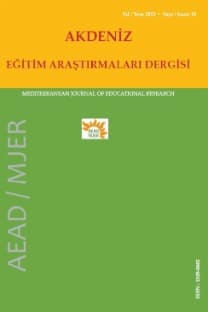Learning as a Fuzzy Structure: New Challenges for Educational Evaluation
___
Acampora, G. Fenza, G. Muñoz, E. Romera, B. (2010). Mejoras en el uso de aprendizaje con árboles fuzzy: un ejemplo de su aplicación en la toma de decisiones de un sistema coordinado. ESTYLF, Huelva. pp 643-648.Arabpour, A., Tata, M.(2008). Estimating the parameters of a fuzzy linear regression model. Iranian Journal of Fuzzy Systems, pp 1-19.
Arellano-Valle,R. Genton, M.(2005). On fundamental skew distributions. Journal of Multivariate Analysis no.96, pp. 93-116.
Barros, L. Bassanezi, R. (2010). Tópicos de lógica fuzzy e biomatemática. Segunda edición. UNICAMP-IMECC.
Cheng, C., Mon, D. (1993). Fuzzy system reliability analysis by interval of confidence, Fuzzy Sets and Systems, pp 29-35.
Chiang, J. (2001). Fuzzy linear programming based on statistical confidence interval and interval-valued fuzzy set, European Journal of Operational Research, pp 65-86.
Choi, S., Kim, K.(2006). Censored fuzzy regression model, Journal of Korean Mathematical Society, pp 623-634.
Coppi, R., Gil, M., Kiers, H.(2006). The fuzzy approach to statistical analysis, Computational Statistics and Data Analysis, pp 1-14.
Cronbach, L. J. (1951). Coefficient alpha and the internal structure of tests. Psychometrika, 16(3), pp 297–334.
Dubois, D.(2006) Possibility theory and statistical reasoning,Computational Statistics and Data Analysis, pp 47- 69.
Fernández, A. (1997). Uso de la Distribución normal en la evaluación del aprendizaje. Estud. pedagóg., no.23, pp.51-63.
García, S. (2002). La Validez y la Confiabilidad en la Evaluación del Aprendizaje desde la Perspectiva Hermenéutica. Rev. Ped, vol.23, n.67, pp. 297-318.
Geyer, C., Meeden, G. (2005). Fuzzy and randomized confidence intervals and p-values, Statistical Science, pp 358-366.
Ojeda, M. (2003). La modelación estadística. Universidad Veracruzana, Universidad Juárez Autónoma de Tabasco. México. pp 71-76.
Parchami, A., Mashinchi, M., Maleki, H. (2006). Fuzzy confidence interval for fuzzy process, Journal of intelligent and Fuzzy Systems, pp 287-295.
Soto, C. Jimenez, C. (2011). Aprendizaje supervisado para la discriminación y clasificación difusa. Dyna rev.fac.nac.minas. vol.78, n.169, pp. 26-33.
Tanaka, H. Uejima, S. Asia, K. (1982). Linear regression analysis with Fuzzy model, IEEE Trans. Systems Man.12 (6) pp 903–907.
Wunsche, A., Nather, W.(2002). Least-squares fuzzy regression with fuzzy random variables, Fuzzy Sets and Systems, pp 43-50.
Zadeh, L. (1978). Fuzzy sets as a basis for a theory of possibility. Fuzzy Sets and Systems, vol1, pp 3-28.
- ISSN: 1309-0682
- Yayın Aralığı: 4
- Başlangıç: 2008
- Yayıncı: Tayfun Taşbilek
Exploring the Gap between Content and Learning Outcomes in Nepalese Technical Education
Yasemin KARAL, Hasan KARAL, Lokman ŞILBIR, Ekrem BAHÇEKAPILI, Murat ATASOY
Metacognitive Awareness and its Impact on Study Strategies in An Online Learning Context
Learning as a Fuzzy Structure: New Challenges for Educational Evaluation
